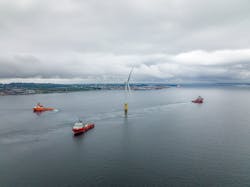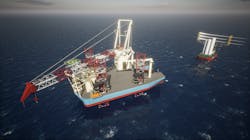Editor's note: This Offshore Wind Energy section first appeared in the July-August 2022 issue of Offshore magazine. Click here to view the full issue.
By Bruce Beaubouef, Managing Editor
Hywind Tampen wind farm on track for 3Q startup
Equinor expects to start up the first seven turbines for the Hywind Tampen wind farm in the North Sea in the current quarter, with the remaining four to be installed next spring.
Due to supply chain bottlenecks, caused largely by steel issues worldwide, the final four tower sections for the wind turbines cannot be delivered until September—too late for this year’s installation weather window.
Four of the seven turbines that have been assembled are now in place at the location in the Tampen area, 140 km offshore western Norway in 260-m to 300-m water depths. Once production begins, they will supply electricity initially to the Gullfaks Field complex and then to Snorre.
According to Equinor, Hywind Tampen will be the world’s largest floating wind farm and the first to supply electricity to oil and gas platforms. Its capacity of 88 MW should satisfy 35% of the electrical power demand at the two field centers.
The seven first turbines, which will power both fields, will have a capacity of 60 MW. All have been tested and found to comply with all quality specifications.
Siemens Gamesa is manufacturing the towers, nacelles and blades; deviations found in steel quality in four tower sections have been corrected.
Due to the market situation for steel, the company has been working with its sub-suppliers and Equinor on ways of speeding up deliveries.
The Hywind Tampen turbines are installed on floating concrete structures with a shared anchoring system.
Maersk awarded US wind installation vessel contract
Maersk Supply Service is due to install the wind turbines at the Beacon Wind farm off the US East Coast for a joint venture between Equinor and bp. The installation of Beacon Wind is expected to start in 2028.
In March 2022, Maersk Supply Service ordered a newbuild wind installation vessel (WIV), the first project for which will be the installation of the U.S. wind park, Empire Wind, also by Equinor and bp.
This new agreement comes in direct continuation of the previously announced contract for Empire Wind.
Designed in house and patented by Maersk Supply Service, the WIV design works in conjunction with a new feeder methodology, expected to be more than 30% more efficient than conventional jackup vessels. This is due both to the WIV’s feeder capabilities and because the WIV stays on location for the duration of the installation, while only the tugs and barges ferry to and from the coast. This enables the WIV to be deployed solely for the purpose of the turbine installation. The solution is also less weather dependent, enabling installation to continue all year round. These elements will all contribute to improving the efficiency of the operations and to bring down the levelized costs of offshore wind.
Maersk Supply Service has partnered with Kirby Offshore Wind, a subsidiary of Kirby Corp., which will construct and operate the feeder barges and tugs in the US, in compliance with the Jones Act. Kirby Offshore Wind will support the Beacon Wind contract further by adding a third barge to the installation spread.
BOEM to conduct environmental review of New York Bight lease areas
The Bureau of Ocean Energy Management (BOEM) will conduct a regional environmental review of six lease areas offshore New York and New Jersey, in an area known as the New York Bight. Leases for these six areas were awarded through BOEM’s February 2022 auction that brought in more than $4.3 billion, a record amount for any U.S. offshore renewable or conventional energy lease sale.
This is the first time BOEM has conducted a regional analysis containing multiple lease areas for offshore renewable energy. Additional environmental analyses specific to each proposed wind energy project will build off this programmatic review once BOEM receives individual Construction and Operations Plans (COPs) from the leaseholders.






